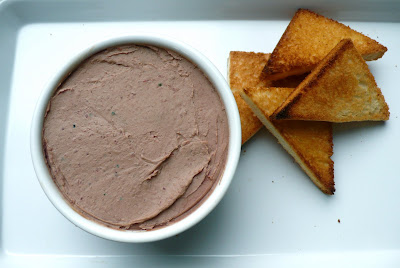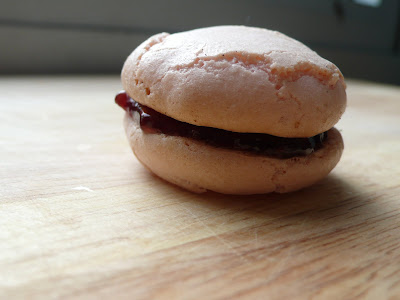
Well, maybe that's not fair. Maybe you have a friend who is especially enamoured with fresh pineapple, eats several on a daily basis, and is desperately seeking a tool that will shave seconds off his pineapple slicing time. But most of us? Most of us really do not need this thing.
I'll admit that I'm a real snob when it comes to kitchen gadgets. I'm convinced that 90% of the things for sale in a kitchen store are a waste of money. Sometimes I go into Williams Sonoma just to see the young couples with their wedding registry gun scanning things like an olive and cherry pitter, a corn stripper, specialty pancake flipping tools, a frozen margarita machine.
Amateurs, I think.
Just buy a good paring knife and call it a day.But, if you're a known kitchen enthusiast, people will always want to buy you kitchen stuff. There are good choices and bad ones. As I write this, there are only five more shopping days until Christmas (actually, four days, thirteen hours, and twenty six more shopping minutes), so I thought I would provide all the last-minute shoppers out there with a little guidance.
In an earlier post, I told you about
the only eight pots and pans that you need to cook almost anything; for those that already have those essentials as well as your typical compliment of spatulas, wooden spoons, measuring cups, and the like, here's my list of my favorite kitchen implements (in no particular order):
1.
Food processor - I started out with a mini food processor and then used it so much that I graduated to a full sized one. I have never looked back. This machine can blend, chop, slice, and even knead dough. Heck, it's so handy that Mark Bittman wrote a whole
piece in the
New York Times praising it. I use my food processor frequently to make pureed soups, dips, and ravioli fillings, and as a tear-free way to chop large quantities of onions.
2.
Hand mixer - If you're a dedicated baker then it probably makes sense to splurge for the full-on
stand mixer, but everyone should be equipped with at least a hand blender. It's inexpensive and compact and can foam egg whites, mix dough, whip cream, and much, much more.
3.
Digital kitchen scale - Not just for people on Weight Watchers! Indispensable if you cook from any non-American cookbooks, which measure most things by weight instead of volume (note: this is actually a much, much more accurate way to do things). Even if you don't, weight measurements come up all over the place. It's best to have a scale.
4.
Mandoline slicer - For slicing/chopping, much more precise than a knife and much speedier. Can slice to 1/16" thickness and dispenses with large chopping jobs in a blink of an eye.
5.
Pasta maker - If you're like me and think that there's no better way to spend an afternoon than rolling out fresh pasta on a hand crank machine, this little Imperia is perfect for you. I probably use this machine once a month, and having it around has thoroughly ruined me for store bought pasta.
6.
Spice grinder - Freshly ground spices beat the pants off the pre-ground variety. If you invest in a small spice grinder, you can buy whole spices and grind them to use. You'll find that they're more pungent and their flavors more complex.
7.
Mise en place bowls - When I'm cooking, I do all the chopping/slicing work at the beginning and have all of my prepared ingredients ready to go in individual bowls (a practice called
mise en place by the French). This makes the actual cooking process a breeze, and lets you feel like you're on a cooking show!
8.
How To Cook Everything, by Mark Bittman - There was a time in my life when I used to think that Googling a cooking question was a reliable way to find the right answer. Now I turn to
How to Cook Everything and I can promise that I end up with much better information. It's a fantastic, comprehensive reference material for to getting everything from basic information (what internal temperature should pork be cooked to?) to creative guidance (what are some variations I can make to a basic red sauce?).
9.
Pepper mill - Along the same lines as freshly ground spices, there is even less excuse to EVER use pre-ground pepper, which pales in comparison to the fresh stuff.
10.
Pastry bag and tips -This might seem intimidating, but once you get a little bit of practice with a pastry bag, it becomes very easy to use. It can be used for everything from filling ravioli to decorating a cake.
And, some items on my wish list:
1.
Food mill - Essential for making things like apple sauce, smooth jams, anything where you're separating seeds, skins, and fibers away from pulp/juice.
2.
Salad spinner - Somehow I just haven't gotten around to buying a salad spinner, and it's really annoying to have to towel dry vegetables after washing them. This collapsible one would be perfect for a 'storage challenged' person such as myself.
3.
Japanese chef's knife - The most important tool you have in your kitchen is a your chef's knife. Most of the chefs that I know use Western style, Japanese made knives. This one by Togiharu is far from the priciest option (think $500 and up for really high-end ones), but comes highly recommended.
4.
Sharpening stone and DVD - There's no point in having great knives unless you keep them sharp
(sharp is different than
honed, which is what you do when you scrape them across that wand-like honing steel in your knife block)
. I currently trek downtown to Sur La Table once every couple of months to have my knives sharpened. It's a waste of time and money, so I'm intent on learning to do it myself.
5.
Nutmegs - It's nice to keep a whole nutmeg or two on hand and grind a dusting into anything from mac and cheese to cookies to sauteed greens. The spice deepens the flavors of both sweet and savory dishes, and loses its pungency quickly once ground.
6.
Good to the Grain, by Kim Boyce - When you hear enough good things about a cookbook, you just have to buy it. I've heard Boyce's chocolate chip cookies alone are worth the price of the book.
7.
Kitchen timer - You can spend $20 on a kitchen timer, or you can keep telling yourself that you'll remember to get up from the couch when 17 minutes are up. Your choice.
8.
Mortar & pestle - I love manual tools, and picture myself
muddling things with this mortar and pestle, or making garlic paste, I don't know. Plus, it's nice looking and therefore decorative?
9.
Ratio, by Michael Ruhlman - Sounds like it should be a Malcolm Gladwell book, but it's actually by baker extraordinaire Michael Ruhlman. I'm really drawn to cookbooks that deal with principles rather than just providing recipes, and this one exposes the standard ratios (fat:flour, flour:water, etc) at the heart of all cooking and baking.
10.
Slow cooker - Say what you will about slow cookers but who wouldn't want to come home this February to short ribs and potatoes that had been in an all-day braise?
























 So, I roasted a Delicata squash that I had hanging around. I prepped the artichoke hearts, tossed them in boiling water with half a lemon for 15 minutes, sliced them thin, and then sauteed them in a hot skillet with olive oil, salt, and pepper.
So, I roasted a Delicata squash that I had hanging around. I prepped the artichoke hearts, tossed them in boiling water with half a lemon for 15 minutes, sliced them thin, and then sauteed them in a hot skillet with olive oil, salt, and pepper.




















